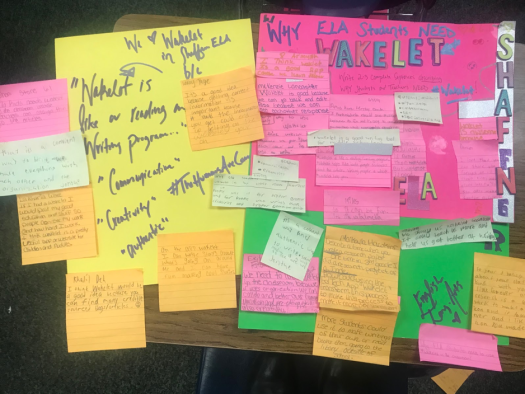Why ELA teachers need Wakelet: Collaboration and Creativity
In the last in her series on using Wakelet in the ELA classroom, Superhuman Samantha J. Shaffner tackles collaboration and creativity
Secondary ELA students can benefit immensely from the closed social media-like environment that EdTech applications allow teachers to establish in the classroom. They also enjoy it, take to it easily, and can use it to translate the communication and collaboration skills they’ve acquired throughout life. In my ELA classes, we use Wakelet as a collaborative writing tool, and the gains and growth my students have made have been quite remarkable.
We use Wakelet almost daily to discuss, share and publish our writing. It’s been a transformative process for my 6th-8th grade ELA students. I was oblivious to the power Wakelet has when it comes to improving student confidence, quality and growth in their writing. Students also find it fun and enjoy engaging with their classmates while learning how to share their ideas with a larger virtual learning community.
We’ll soon be tackling a few larger writing projects that employ the Project Based Learning model. This will require students to start curating their own resources so that myself, as their teacher, and their classmates can learn together. We’re also creating a student literary magazine club to serve as a creative outlet for students who excel in writing and art. I was encouraged to embark on this creative project after students started asking for additional collaboration opportunities on Wakelet outside of the classroom – a truly amazing feeling for an ELA teacher. Just last week, I was very pleased to hear a 6th grade student say to her friend in class, ‘I love Wakelet because I love that you can share feelings and that it shows everybody else’s work. You can also make custom profiles!’

In the spirit of collaboration, I surveyed my students to find out how they feel about using Wakelet in their ELA class. Students were asked to write 1-3 sentences telling me, ‘Why ELA students need Wakelet.’ The responses I received were empowering and insightful:
Why do ELA students need Wakelet, according to students
- ‘Wakelet is a good writing tool for middle school students.’
- ‘So it can be fun; it’s like social media.’
- ‘Wakelet is good because we can go back and edit. Also, because we can see each other’s responses.’
- ‘It’s a good idea because getting correct information is important because you don’t waste time on using bad sources.’
- ‘We should use Wakelet more because having an authentic audience makes us better at writing.’
- ‘Wakelet is a convenient place to write because it helps us stay organized and we share everything with each other.’
- ‘Communication and creativity.’
- ‘I like Wakelet because it makes me excited to write and share.’
- ‘I like choosing my learning activities and articles I get to read and write about.’
- ‘I like to share our class collections on Twitter because it makes me proud of my work.’
In my classroom, after we finish an assignment, I typically look it over and then publish it. I ask students to proofread their work with a partner, and then with me, before submitting it to our collection for that day. Assignments can cover anything from class debates about school uniforms, to responding to NewsELA articles and prompts about modern-day artists and musicians, to writing book reviews.
I often send their reviews to the book authors and it’s great when they respond while the students are still grappling with the literature. Students want to share and collaborate with one another and the outside world as much as they can.
In my 12-year career as an ELA teacher, I’ve never seen the use of a digital tool increase student confidence and agency in the classroom like Wakelet. Students who are shy can now express themselves and all students can peer-edit and share polished writing onto major social media networks like Twitter. They are admitting for the first time that they are proofing all of their writing assignments because they take pride in their hard work and are excited to share it. It’s also fun and engaging for teachers! When I’m grading their work from our class collections, I’m engaged and empowered by the leaps and bounds they have made with taking control of their own learning.
To see examples of this in action, check out my Wakelet profile – @SamanthaShaffn9061 -and head to the sections titled, ‘Student Voice and Change: ELA Blended Learning Menus’ and ‘English Language Arts with Ms. Shaffner: Class Collaborations and Writing Activities.’
Why use Wakelet?
As you have seen throughout this blog series, Wakelet has made our learning environment more organized, student-centered, and collaborative. Learner agency is enhanced and students gain the skills required to succeed in the digital world.
It isn’t enough for teachers to introduce their students to online tools merely by employing school or district-appointed digital learning tools. There’s a world of resources out there that can transform the classroom or, at the very least, allow teachers to innovate. All students, no matter their future plans, benefit from the diverse set of EdTech resources available to them. Wakelet can act as a container for these resources; a virtual whiteboard for lessons and projects; and a laboratory within which students can start to experiment with presenting their own content in a closed and safe social media-like environment.
My heart melts when I see students sincerely enjoying the publication of their work, even in a limited and safe way. My 12 and 13-year-old students desperately want to see themselves as grown adults, and I think they feel validated when their work is shared with the world outside the classroom.
The best part is, students start developing into responsible users of social media. My students, in particular, are now asking questions like, ‘Did Lois Lowry like my video?’ and ‘Can the best collection piece go live on Twitter today?’ It may not seem like a big deal but my students see the potential of networking through social sites to learn about the world and share that learning with others.
I recommend Wakelet for ELA teachers looking to push the envelope, innovate and expand curriculum delivery. The indirect impact on students is remarkable. My student’s love using Wakelet’s features and seeing their work published. They’ve taken to the technology easily and the platform provides an understanding that the digital world has more to offer than fun YouTube videos, Instagram and Snapchat.
I think Wakelet’s brilliance is that its team acknowledges it’s not the only tool for educators. Instead, it focuses on creating a platform that teachers can, and should, bring into the classroom. A video, a tweet, an article, instructions from teachers, and the students’ assignments can be seamlessly added to a shared collaborative collection.
Wakelet doesn’t seek to intrude on more specialized applications. Instead, it allows the seamless incorporation of various resources into collections that have wide applications, not only in teaching, but other professions too. I’m excited to continue bringing Wakelet’s features into my lesson plans and to see innovative implementations from other users. The platform can only grow and continue to improve.
To read part two of Samantha’s series, click here

Samantha J. Shaffner is a secondary English Language Arts Teacher at Millennium Community School in, Columbus, OH. This is Samantha’s 12th year in the ELA classroom within an urban charter school setting, where she has also held a variety of administrative positions including director of blended learning and district testing coordinator.
Samantha has a passion for blended learning program/assessment design and implementation of best practices within the field of ELA education, and is an active/contributing member of both the National Council of Teachers of English (NCTE) as well as the Ohio Council for Teachers of English Language Arts (OCTELA).
Samantha enjoys writing and conducting research about cutting edge EdTech tools and applications, as well as serving as a Wakelet Ambassador.
Wakelet profile: @SamanthaShaffner9061,
Twitter: @SamanthaShaffn2
LinkedIn: Samantha J. Shaffner

